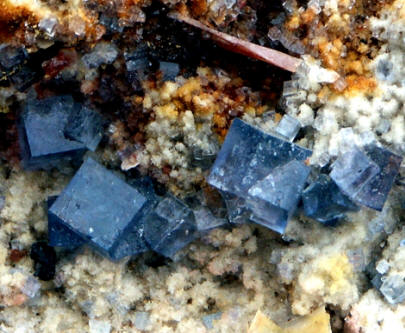Hydrofluoric Acid

FLUORINE is a poisonous pale yellow gaseous element found in Group VIIb (i.e. the Halogen Group of elements) of the periodic table. Fluorine is the most reactive element known. It reacts violently with water liberating oxygen and forming hydrofluoric acid (HF). Fluorine even reacts with some of the normally inert noble gases such as Krypton and Xenon.
Acid Burn
Hydrofluoric (HF) acid is used mainly for industrial purposes (e.g. glass etching, metal cleaning, electronics manufacturing). HF acid also may be found in home rust removers. Exposure usually is accidental and often is due to inadequate use of protective measures. HF acid burns are a unique clinical entity. Dilute solutions deeply penetrate before dissociating, thus causing delayed injury and symptoms. Burns to the fingers and nail beds may leave the overlying nails intact, and pain may be severe with little surface abnormality. Severe burns occur after exposure of concentrated (ie, 50% or stronger solution) HF acid to 1% or more body surface area (BSA), exposure to HF acid of any concentration to 5% or more BSA, or inhalation of HF acid fumes from a 60% or stronger solution. The vast majority of cases involve only small areas of exposure, usually on the digits. (reference 82)
Pathophysiology
The 2 mechanisms that cause tissue damage are corrosive burn from the free hydrogen ions and chemical burn from tissue penetration of the fluoride ions. Fluoride ions penetrate and form insoluble salts with calcium and magnesium. Soluble salts also are formed with other cations but dissociate rapidly. Consequently, fluoride ions release, and further tissue destruction occurs.
Anhydrous hydrogen fluoride and hydrofluoric acid are extremely corrosive to all tissues of the body. Skin contact results in painful deep-seated burns that are slow to heal. Burns from dilute (<50%) HF solutions do not usually become apparent until several hours after exposure; more concentrated solutions and anhydrous HF cause immediate painful burns and tissue destruction. HF burns pose unique dangers distinct from other acids such as HCl and H2SO4: undissociated HF readily penetrates the skin, damaging underlying tissue; fluoride ion can then cause destruction of soft tissues and decalcification of the bones. (reference)
Hydrofluoric acid and HF vapor can cause severe burns to the eyes, which may lead to permanent damage and blindness. At 10 to 15 ppm, HF vapor is irritating to the eyes, skin, and respiratory tract. Exposure to higher concentrations can result in serious damage to the lungs, and fatal pulmonary edema may develop after a delay of several hours. Brief exposure (5 min) to 50 to 250 ppm may be fatal to humans. Ingestion of HF can produce severe injury to the mouth, throat, and gastrointestinal tract and may be fatal. Hydrofluoric acid is a clear, colorless liquid, miscible with water, with an acrid, irritating odor. It is an extremely corrosive liquid and vapor that can cause severe injury via skin and eye contact, inhalation, or ingestion.
Hydrofluoric acid has not been reported to be a human carcinogen. No acceptable animal test reports are available to define the developmental or reproductive toxicity of HF. The OSHA Permissible Exposure Limit is 3 ppm (as fluoride). Anhydrous HF has a vapor pressure of 775 mm Hg at 20° C, while Hydrofluoric acid has a vapor pressure of 14 mm Hg at 20° C.
Hydrofluoric acid corrosivity
Hydrofluoric acid attacks glass, concrete, and many metals. It also attacks carbonaceous natural material such as woody materials, leather, and rubber.
Some materials resist the corrosive action of the acid, such as platinum, wax, polypropylene, polyethylene, and Teflon. In contact with metals with which it will react, hydrogen gas is liberated and the danger exists of a spark or flame resulting in an explosion. HF is used in many labs and in the glass shop on a regular basis. It should always be stored in plastic bottles. Containers of HF should be stored in secondary containers made of polyethylene in areas separate from incompatible materials. All work with hydrofluoric acid should be conducted in a fume hood to prevent exposure by inhalation. Splash goggles and Neoprene gloves as well as laboratory coats should be worn at all times to prevent eye and skin contact.
Sulfur hexafluoride (SF6)
The substance
At environmental temperatures sulfur hexafluoride is a colorless, odorless, non-toxic
gas of high chemical stability and inertness. It is also non-flammable and about
5 times heavier than air - one of the heaviest known gases. (reference)
Use
The major use of sulfur hexafluoride is in the electricity supply industry, where
it is used as an electrical insulator in transformers and switch-gear, and in magnesium
smelting because of its inertness. It also has some minor use in the semiconductor
sector, as tracer gas for atmospheric analysis, in tennis balls, high performance
vehicle tires and in the cushioning soles of some trainers.
Major emissions
Sulfur hexafluoride is a man-made chemical not found naturally in the environment.
The major sources of sulfur hexafluoride release include leakage from electrical
switchgear, from magnesium smelting processes and use in semiconductor manufacture.
Impacts on human health and environment
Excessive exposure to sulfur hexafluoride may affect the brain. The main impact of sulfur hexafluoride on the environment is as a greenhouse gas, influencing climate change. Consequently sulfur hexafluoride is controlled under the Kyoto Protocol. Of the internationally monitored greenhouse gases it has by far the highest global warming potential (23,000 times that of carbon dioxide), however it is only released in small amounts. Due to its stability it has a very long atmospheric lifetime.
Emission to air reporting threshold: 50 kg/year
(back)

Connect with us
Contact us today